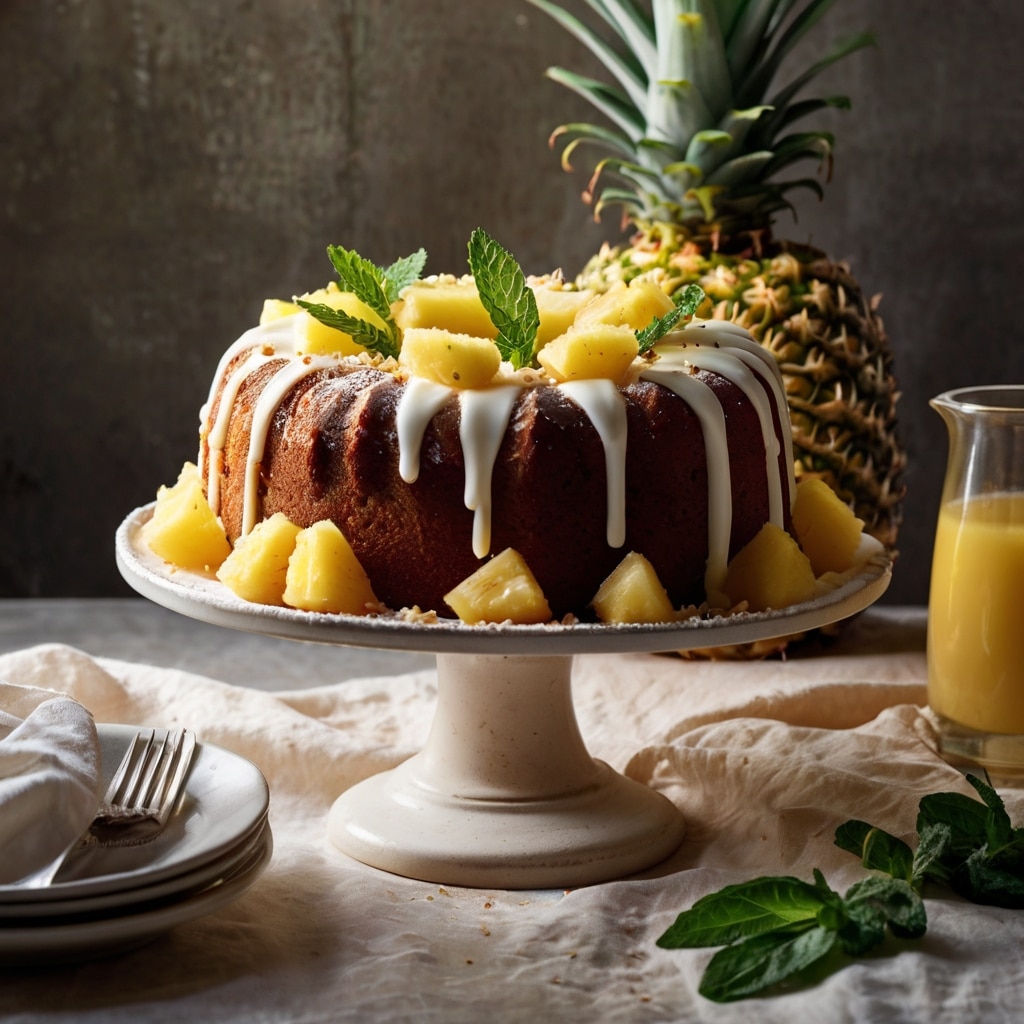Pineapple Cream Cheese Pound Cake isn’t the kind of cake you just casually make, it’s the kind you whisper about after the last slice has gone missing. The first bite hits with a buttery density, almost velvet, and then that sweet tropical zing of pineapple sneaks up behind it. I’ve had people look me straight in the eye after trying it and say, “This can’t be real.” But it is, and it’s shockingly simple once you know the tricks.
Pineapple Cream Cheese Pound Cake has a history tucked inside Southern kitchens, where pound cakes are practically sacred. What makes this one different is the cream cheese—it doesn’t just soften the crumb, it gives that tangy, rich background note that keeps you eating even when you’re full. And the pineapple? That’s the sunshine, the bite of acidity that cuts through fat like a knife through warm butter. Together, the two build a cake that feels both indulgent and balanced.
Pineapple Cream Cheese Pound Cake is special for its texture. Dense but not heavy. Moist but never soggy. The cream cheese works as an emulsifier, binding fat and sugar, creating a smooth batter that bakes into something with almost no grain. A pound cake, when done right, should slice cleanly and still feel melt-in-your-mouth. That’s the bar.
Ingredients & Substitutions
Pineapple Cream Cheese Pound Cake demands respect for ingredients. Don’t skimp. Here’s the base lineup:
- 1 cup unsalted butter, softened
- 1 (8 oz) package cream cheese, softened
- 3 cups granulated sugar
- 6 large eggs, room temperature
- 3 cups all-purpose flour, sifted
- 1/2 teaspoon baking powder
- 1/4 teaspoon salt
- 1 teaspoon pure vanilla extract
- 1/2 cup crushed pineapple, well-drained
- Optional: zest of one lemon for brightness
Pineapple Cream Cheese Pound Cake doesn’t mind substitutions, but you must be wise. Margarine? Never. Coconut oil? Yes, but you’ll lose some richness. Gluten-free flour blend works but choose one with xanthan gum or you’ll end up with crumbs, not cake. Vegan cream cheese can step in, but flavor shifts—slightly tangier, sometimes saltier. Pineapple should be canned in juice, not syrup, or you risk cloying sweetness.
Pineapple Cream Cheese Pound Cake gets better when ingredients are chosen with thought. Eggs at room temp whip smoother into the batter, sugar should be fine-grain for easier creaming, and don’t even think about skipping the sifted flour. Sifting adds air. Air means lift. Pound cake without lift? A brick.
Step-by-Step Instructions
Pineapple Cream Cheese Pound Cake begins with patience. Cream butter and cream cheese until they’re one, smooth and pale like whipped satin. This step isn’t a “quick mix,” it’s the foundation. Three to five minutes minimum, otherwise your cake will be dense in the wrong way.
Pineapple Cream Cheese Pound Cake needs sugar to be added slowly. A spoonful at a time, beating in fully before adding more. This dissolves sugar crystals gradually, preventing a gritty crumb. If you dump it all in at once, good luck—your cake will taste sweet but chew like sand.
Pineapple Cream Cheese Pound Cake moves forward with eggs. Add them one at a time, each one fully incorporated before cracking the next. Professionals know why: too many eggs at once overwhelm the fat, causing curdling. If it happens, don’t panic—just sprinkle in a tablespoon of flour to bring it back together.
Pineapple Cream Cheese Pound Cake requires flour folded gently. Low speed mixing, or better, hand-folding with a spatula. Over-mix here and gluten wakes up, tightening the cake crumb until it bakes rubbery. Think slow, think lazy folding.
Pineapple Cream Cheese Pound Cake finishes with pineapple. Drain it well. Squeeze between paper towels if you must, because excess juice sinks to the bottom and creates wet pockets. Fold it in last, with vanilla and zest, just until scattered through. That’s it.
Pineapple Cream Cheese Pound Cake bakes in a greased and floured bundt pan. 325°F, low and slow, for about 75 to 85 minutes. Do not open the oven door in the first 50 minutes—air loss equals collapse. Test with a skewer; it should come out clean, maybe with a moist crumb clinging.
Cooking Techniques & Science
Pineapple Cream Cheese Pound Cake thrives because of the creaming method. When fat and sugar are beaten, air pockets form. Those pockets expand in the oven, giving pound cake its rise. Skip this step properly and you’re baking cement.
Pineapple Cream Cheese Pound Cake uses cream cheese for more than flavor. Cream cheese contains emulsifiers, which allow fat and water to stay friends inside the batter. That’s why the texture feels impossibly smooth. Without it, the cake risks splitting, creating greasy streaks.
Pineapple Cream Cheese Pound Cake also benefits from pineapple’s acidity. Acids tenderize proteins, gently breaking down gluten so the crumb stays soft. It’s the quiet science working behind the scenes. Professionals lean on this trick in countless recipes—balance fat with acid for better texture.
Pineapple Cream Cheese Pound Cake needs the right tools. A heavy bundt pan distributes heat evenly, preventing raw centers. Thin pans scorch edges. And a stand mixer with paddle attachment is ideal. Hand mixers work but can’t cream fats as efficiently.
Serving & Pairing Suggestions
Pineapple Cream Cheese Pound Cake slices like a dream when cooled completely. Use a serrated knife, not straight-edged. Each slice should hold shape, no crumbling.
Pineapple Cream Cheese Pound Cake pairs beautifully with tropical accents. Toasted coconut sprinkled on top, or a drizzle of rum glaze. A scoop of coconut sorbet beside it makes the whole thing feel like vacation on a plate.
Pineapple Cream Cheese Pound Cake also goes savory. Yes, savory. Serve thin slices with sharp cheeses—aged cheddar or gouda—on a holiday platter. That tangy-sweet balance is surprising, but it works.
Pineapple Cream Cheese Pound Cake plays well with drinks. A hot mug of strong coffee balances sweetness. A glass of chilled Riesling, fruity but acidic, is heavenly. For non-alcoholic, try iced hibiscus tea—the floral tartness matches pineapple.
Conclusion
Pineapple Cream Cheese Pound Cake is proof that a recipe can be both simple and deeply technical. It relies on fundamentals—creaming, folding, low-temp baking—but the reward is extraordinary. Moist, buttery, tangy, tropical, all in one bite.
Pineapple Cream Cheese Pound Cake deserves patience. Don’t rush the creaming, don’t flood the batter with pineapple juice, and don’t slam the oven door mid-bake. Respect the cake and it will respect you back.
Pineapple Cream Cheese Pound Cake, at its heart, is Southern tradition colliding with tropical flair. That’s why it stands out. That’s why it lasts. And that’s why, if you bake it right, someone will ask for the recipe and never give your plate back.
FAQs
How do I keep my Pineapple Cream Cheese Pound Cake moist?
Keep it wrapped tightly once cooled. The cream cheese locks in moisture, but exposure to air dries it out fast. Storing at room temperature for 2–3 days works fine, or freeze slices individually for longer.
Can I use fresh pineapple instead of canned?
Yes, but only if it’s very ripe and finely crushed. Drain it thoroughly. Fresh pineapple contains more natural enzymes that can sometimes affect texture, but in small amounts, it works beautifully.
Why did my Pineapple Cream Cheese Pound Cake sink in the middle?
Usually it’s from opening the oven too soon, under-baking, or excess pineapple juice. Always drain pineapple well and check doneness with a skewer in multiple spots.
Do I need to glaze the Pineapple Cream Cheese Pound Cake?
Not at all. It’s rich and flavorful on its own. But a simple glaze of powdered sugar and pineapple juice adds shine and extra tang.
Can I bake Pineapple Cream Cheese Pound Cake in loaf pans instead of a bundt?
Yes, the batter divides into two standard loaf pans. Baking time reduces to around 55–65 minutes, but still test for doneness.

Olivia P. is a seasoned food blogger at Tastywink, sharing delicious, easy-to-follow recipes inspired by him passion for home cooking. With years of culinary blogging experience, he brings flavor, creativity, and a personal touch to every dish.
